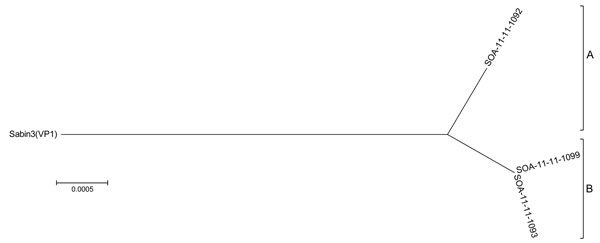Volume 18, Number 6—June 2012
Dispatch
Immunodeficiency-associated Vaccine-Derived Poliovirus Type 3 in Infant, South Africa, 2011
Figure

Figure. . . Neighbor-joining tree of immunodeficiency-associated vaccine-derived poliovirus isolates from infant, South Africa, 2011. The tree was derived from the viral protein (VP) 1 region and rooted at the Sabin 3 reference strain, showing classification as lineage A or B. South Africa (SOA) isolates are identified by 2 digits indicating year of receipt, 2 digits indicating year of onset of paralysis (11), and 4 digits indicating case number. SOA-11-11-1092 is a representative cerebrospinal fluid sample; SOA-11-11-1099 and SOA-11-11-1093 are representative stool samples. Scale bar indicates nucleotide substitutions per site.
References
- Kew OM, Sutter RW, de Gourville EM, Dowdle WR, Pallansch MA. Vaccine-derived polioviruses and the endgame strategy for global polio eradication. Annu Rev Microbiol. 2005;59:587–635. DOIPubMedGoogle Scholar
- Alexander JP Jr, Gary HE Jr, Pallansch MA. Duration of poliovirus excretion and its implications for acute flaccid paralysis surveillance: a review of the literature. J Infect Dis. 1997;175(Suppl 1):S176–82. DOIPubMedGoogle Scholar
- Kew OM, Sutter RW, Nottay BK, McDonough MJ, Prevots DR, Quick L, Prolonged replication of a type 1 vaccine-derived poliovirus in an immunodeficient patient. J Clin Microbiol. 1998;36:2893–9.PubMedGoogle Scholar
- Misbah SA, Lawrence PA, Kurtz JB, Chapel HM. Prolonged faecal excretion of poliovirus in a nurse with common variable hypogammaglobulinaemia. Postgrad Med J. 1991;67:301–3. DOIPubMedGoogle Scholar
- Martín J, Dunn G, Hull R, Patel V, Minor PD. Evolution of the Sabin strain of type 3 poliovirus in an immunodeficient patient during the entire 637-day period of virus excretion. J Virol. 2000;74:3001–10. DOIPubMedGoogle Scholar
- Bellmunt A, May G, Zell R, Pring-Akerblom P, Verhagen W, Heim A. Evolution of poliovirus type I during 5.5 years of prolonged enteral replication in an immunodeficient patient. Virology. 1999;265:178–84. DOIPubMedGoogle Scholar
- Shahmahmoodi S, Mamishi S, Aghamohammadi A, Aghazadeh N, Tabatabaie H, Gooya MM, Vaccine-associated paralytic poliomyelitis in immunodeficient children, Iran, 1995–2008. Emerg Infect Dis. 2010;16:1133–6. DOIPubMedGoogle Scholar
- World Health Organization. Polio laboratory manual, 4th ed. Geneva: The Organization; 2004. WHO/IVB/04.10.
- Kilpatrick DR, Yang CF, Ching K, Vincent A, Iber J, Campagnoli R, Rapid group-, serotype-, and vaccine strain-specific identification of poliovirus isolates by real-time reverse transcription-PCR using degenerate primers and probes containing deoxyinosine residues. J Clin Microbiol. 2009;47:1939–41. DOIPubMedGoogle Scholar
- Gromeier M, Bossert B, Arita M, Nomoto A, Wimmer E. Dual stem loops within the poliovirus internal ribosomal entry site control neurovirulence. J Virol. 1999;73:958–64.PubMedGoogle Scholar
- Haller AA, Stewart SR, Semler BL. Attenuation stem-loop lesions in the 5′ noncoding region of poliovirus RNA: neuronal cell-specific translation defects. J Virol. 1996;70:1467–74.PubMedGoogle Scholar
- Dunn G, Begg NT, Cammack N, Minor PD. Virus excretion and mutation by infants following primary vaccination with live oral poliovaccine from two sources. J Med Virol. 1990;32:92–5. DOIPubMedGoogle Scholar
- Minor PD, Dunn G, Evans DM, Magrath DI, John A, Howlett J, The temperature sensitivity of the Sabin type 3 vaccine strain of poliovirus: molecular and structural effects of a mutation in the capsid protein VP3. J Gen Virol. 1989;70:1117–23. DOIPubMedGoogle Scholar
- Saitou N, Nei M. The neighbor-joining method: a new method for reconstructing phylogenetic trees. Mol Biol Evol. 1987;4:406–25.PubMedGoogle Scholar
- Jorba J, Campagnoli R, De L, Kew O. Calibration of multiple poliovirus molecular clocks covering an extended evolutionary range. J Virol. 2008;82:4429–40. DOIPubMedGoogle Scholar
Page created: May 10, 2012
Page updated: May 10, 2012
Page reviewed: May 10, 2012
The conclusions, findings, and opinions expressed by authors contributing to this journal do not necessarily reflect the official position of the U.S. Department of Health and Human Services, the Public Health Service, the Centers for Disease Control and Prevention, or the authors' affiliated institutions. Use of trade names is for identification only and does not imply endorsement by any of the groups named above.